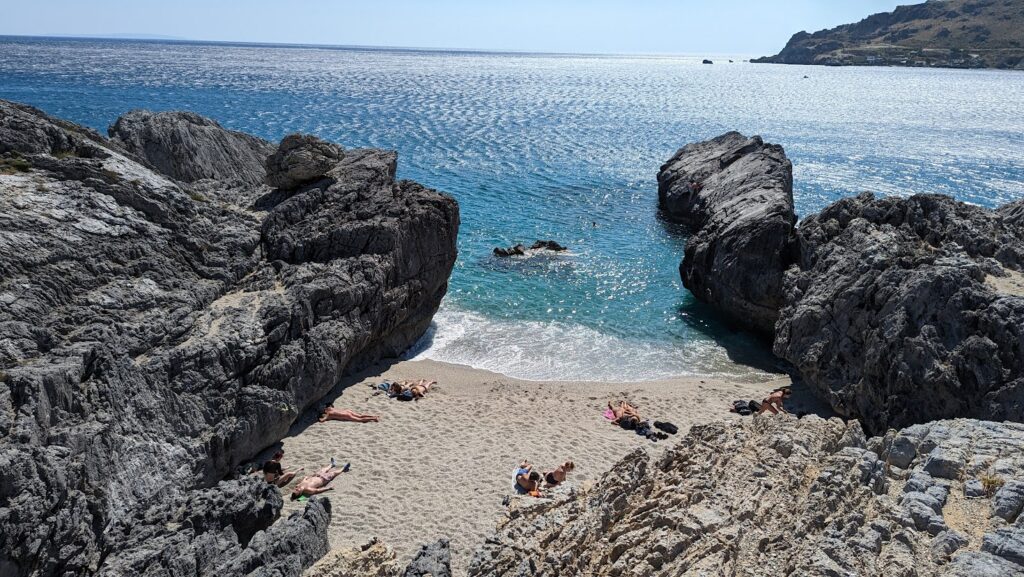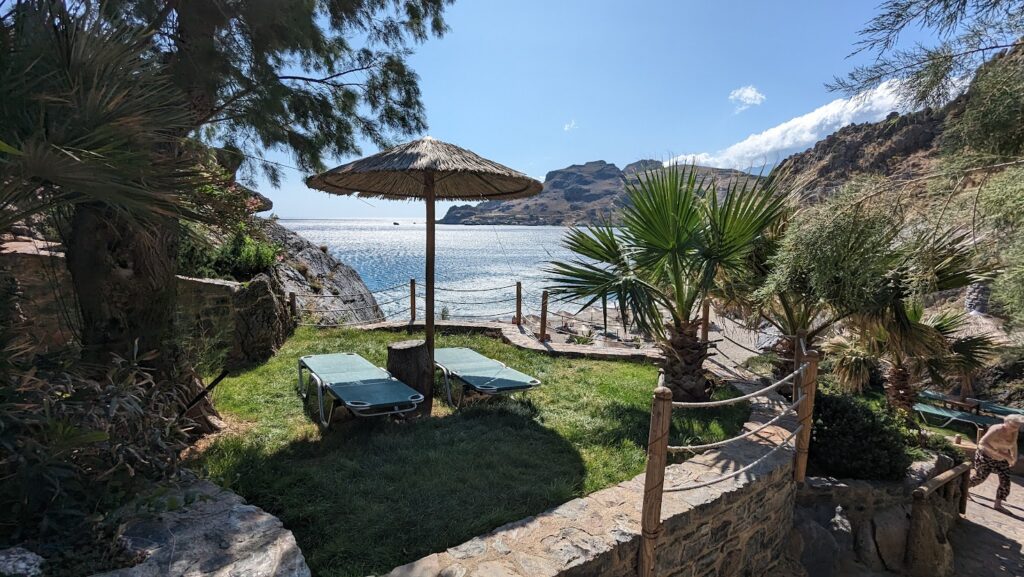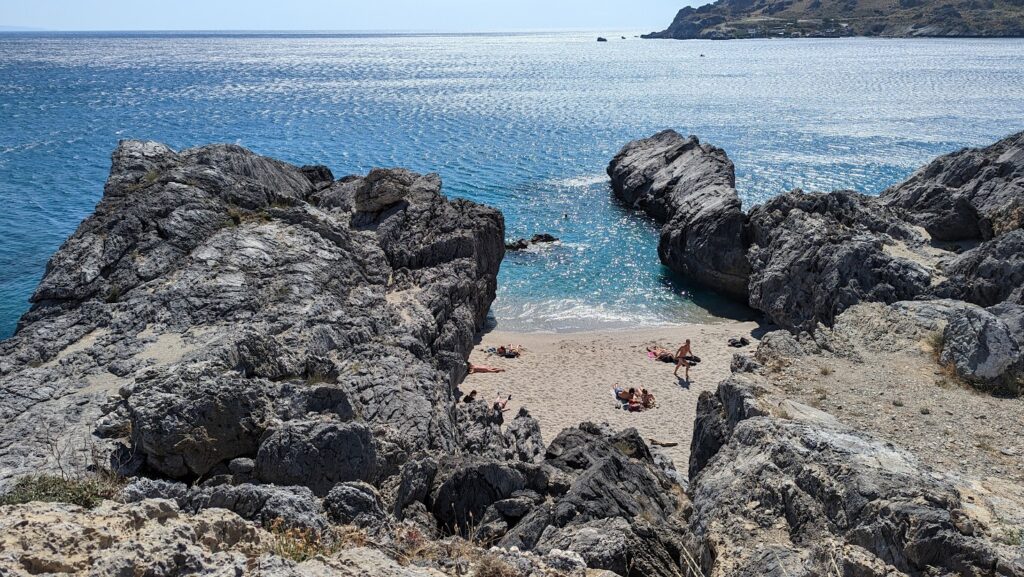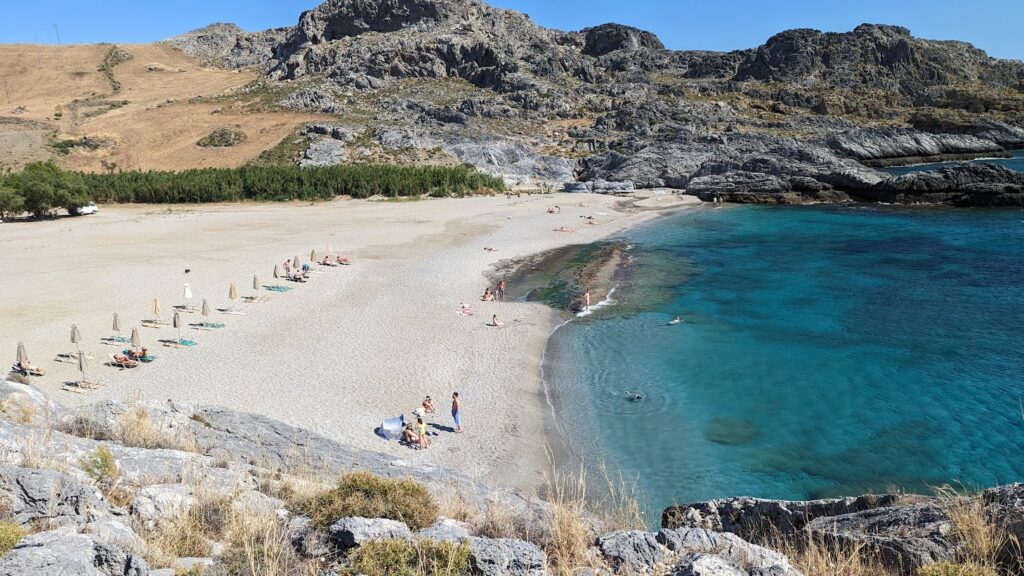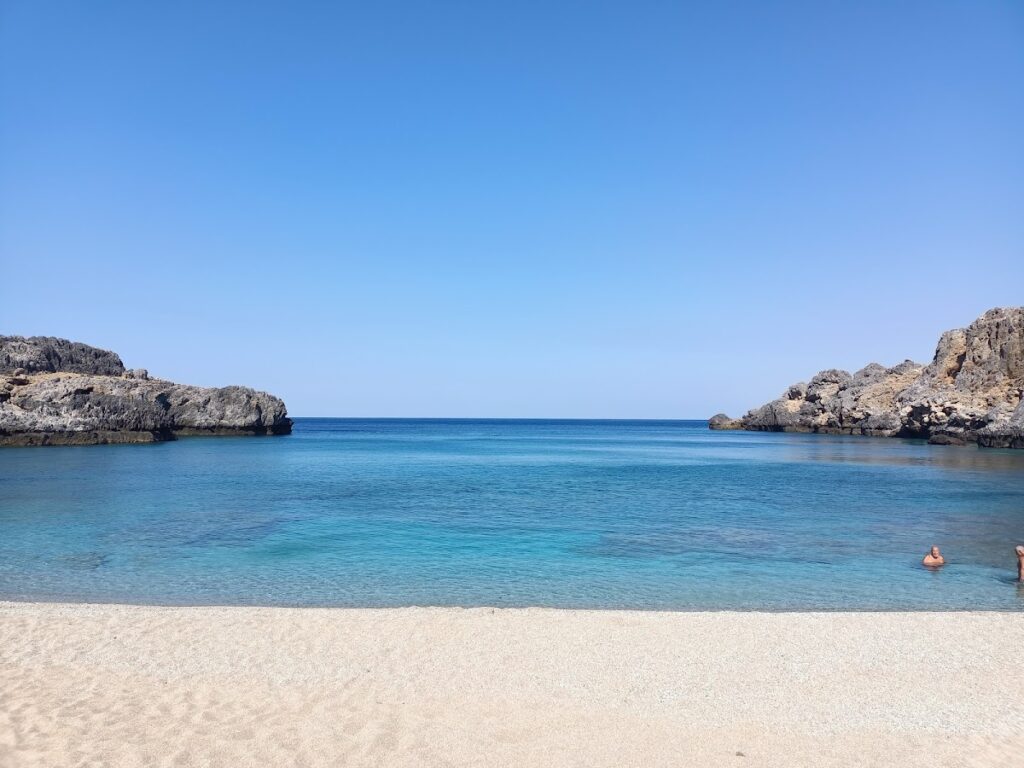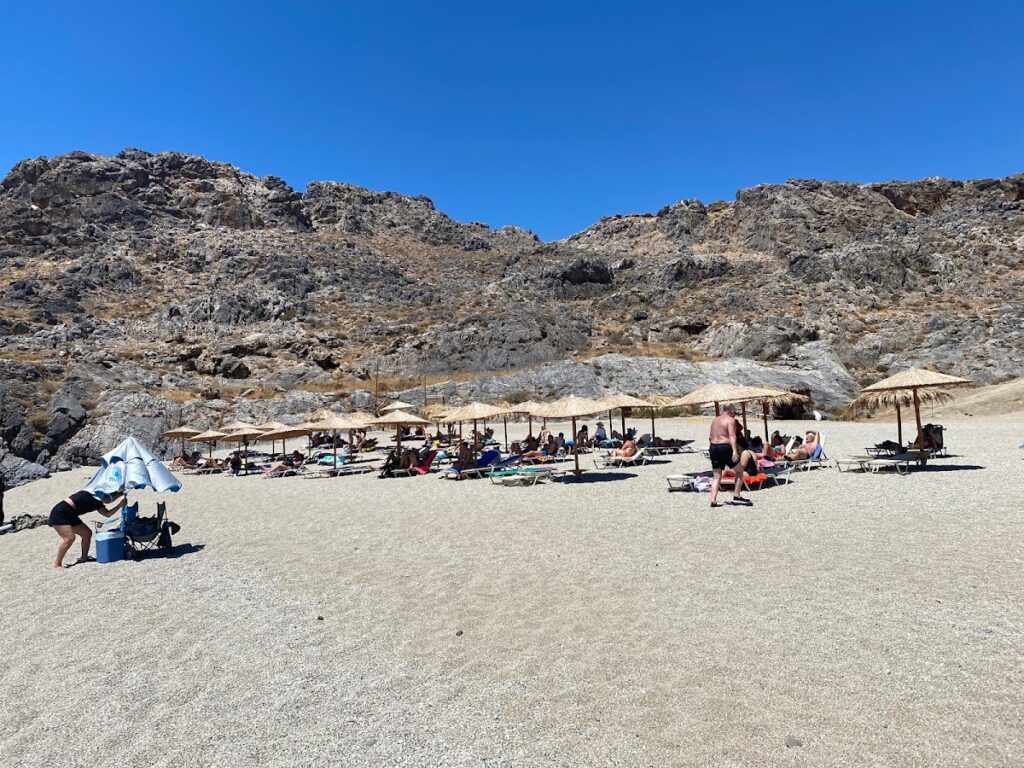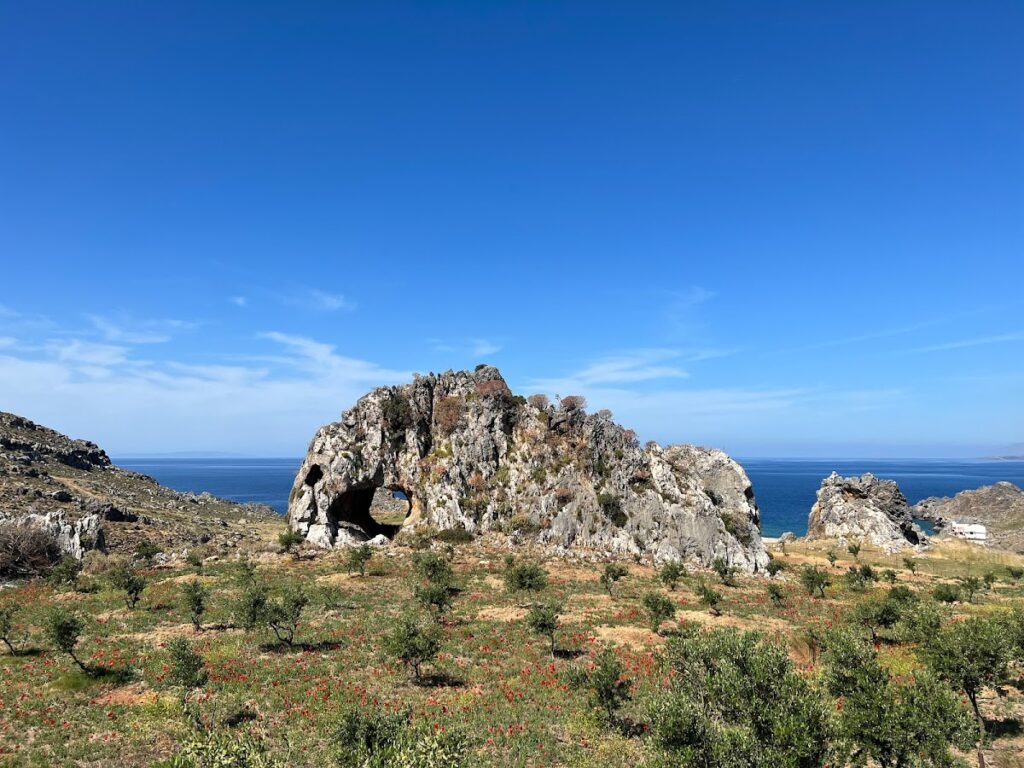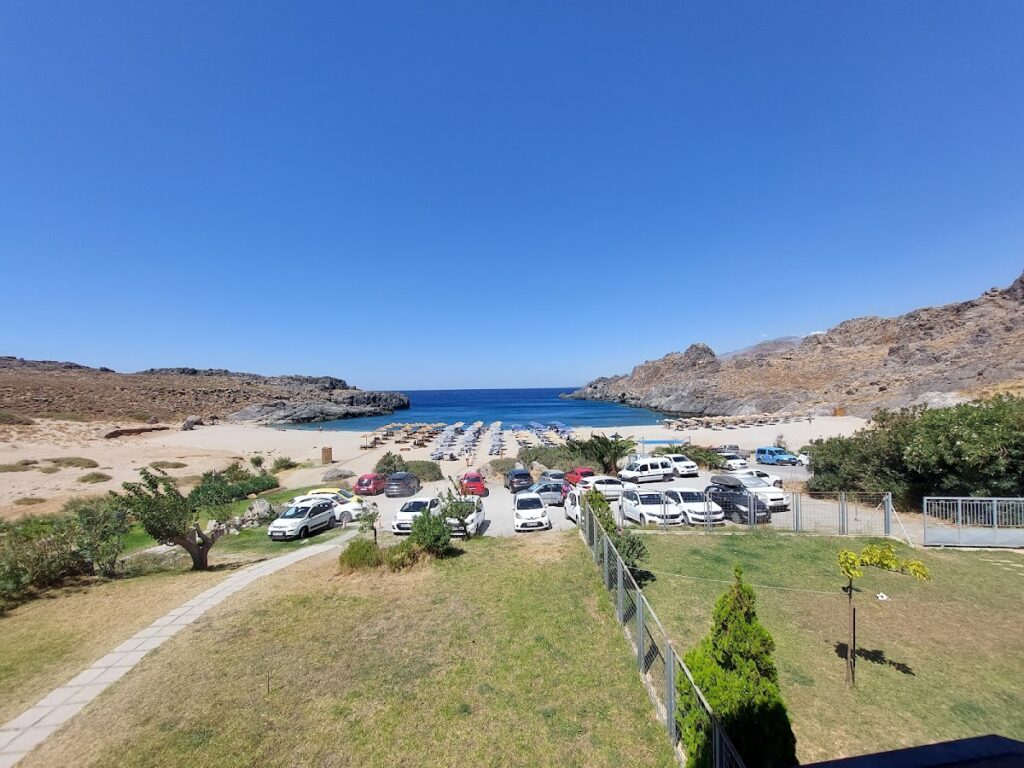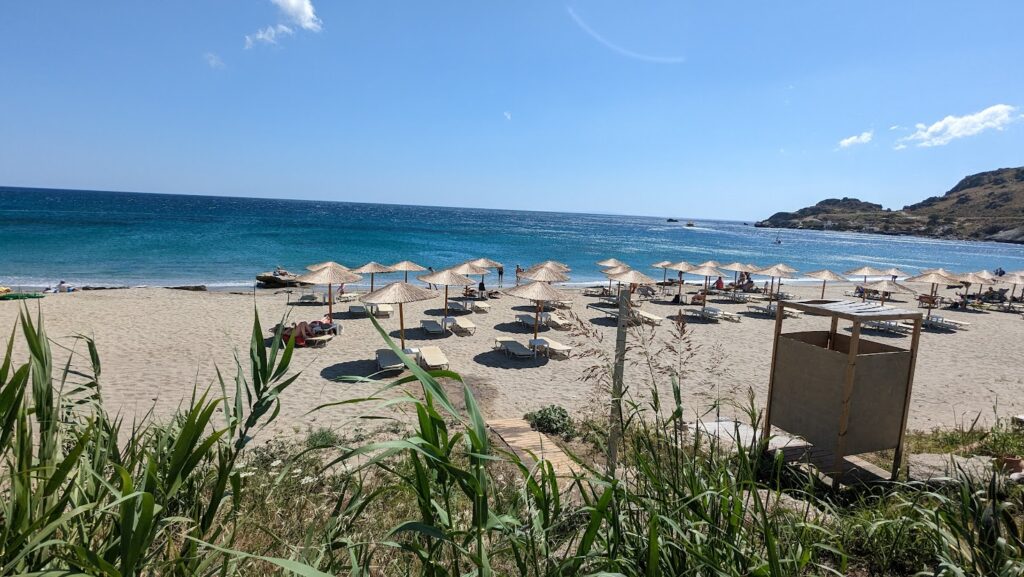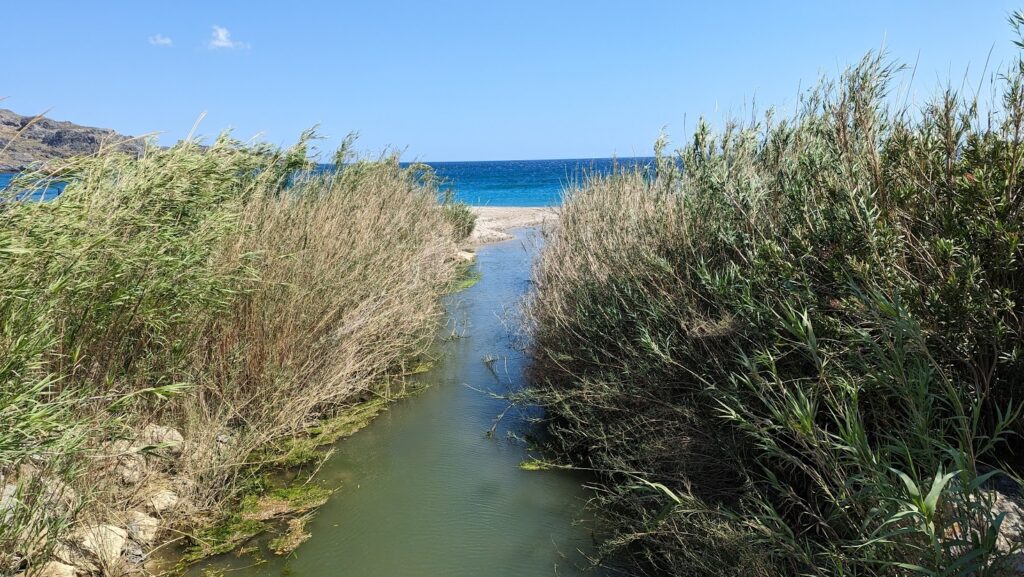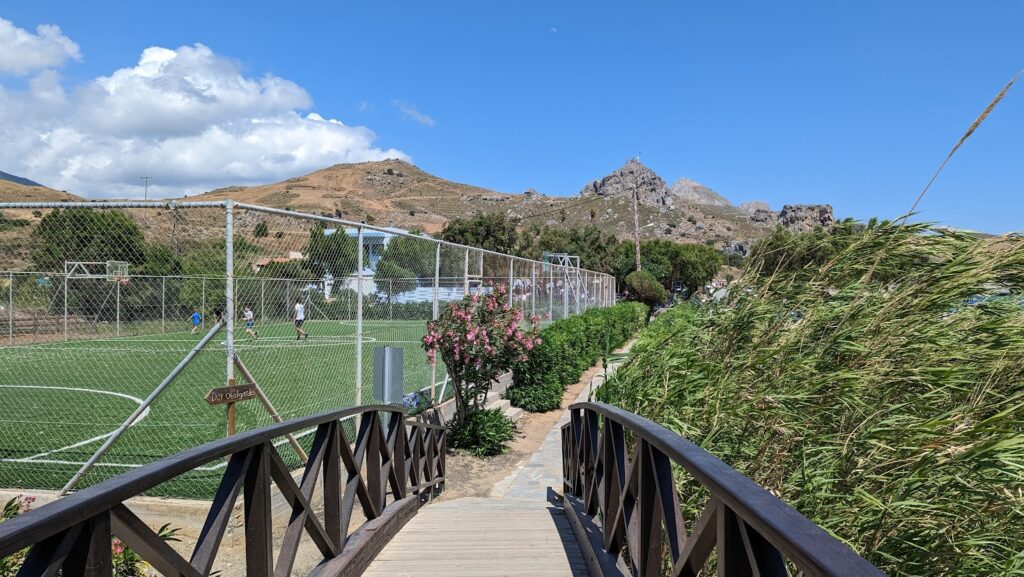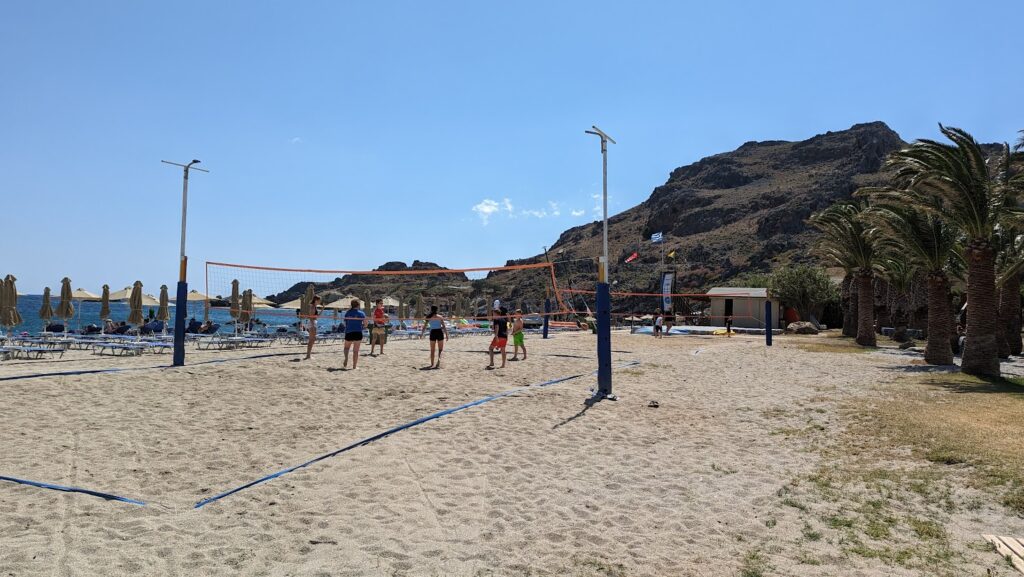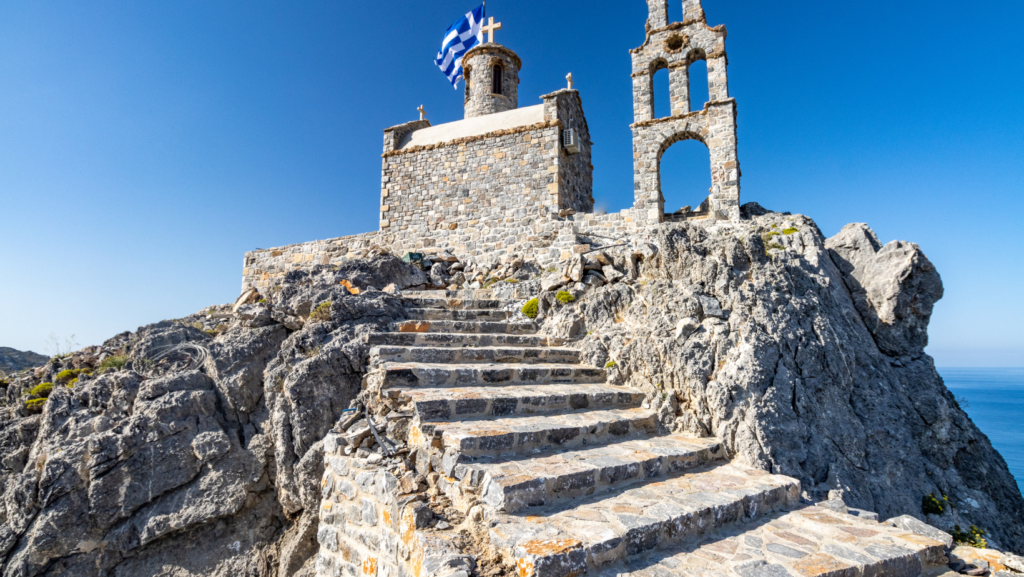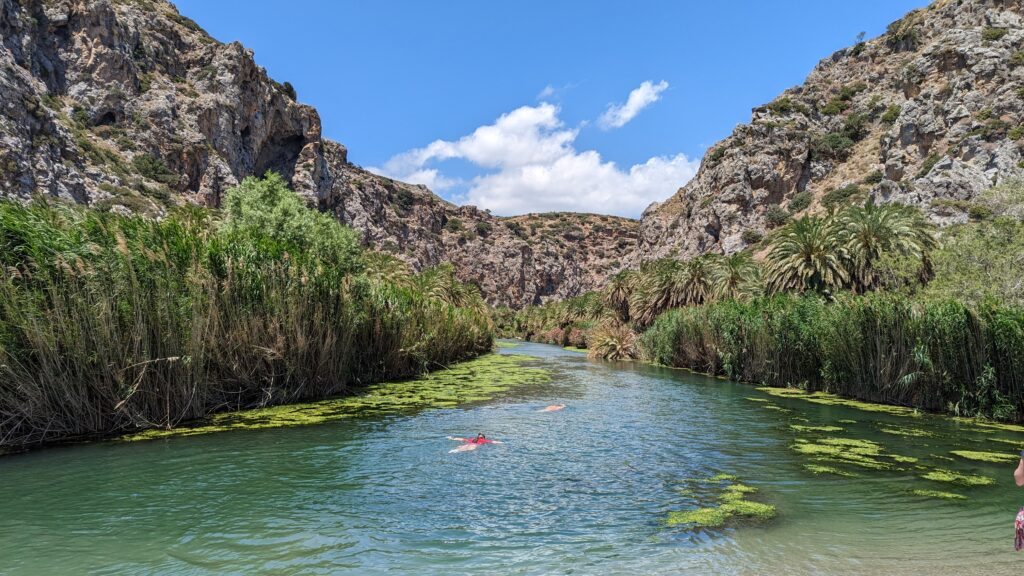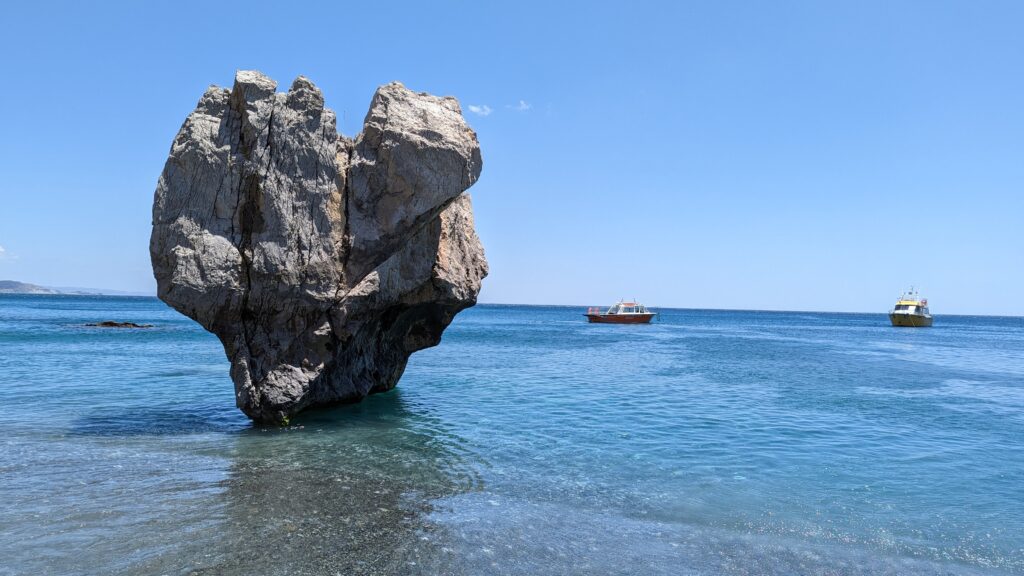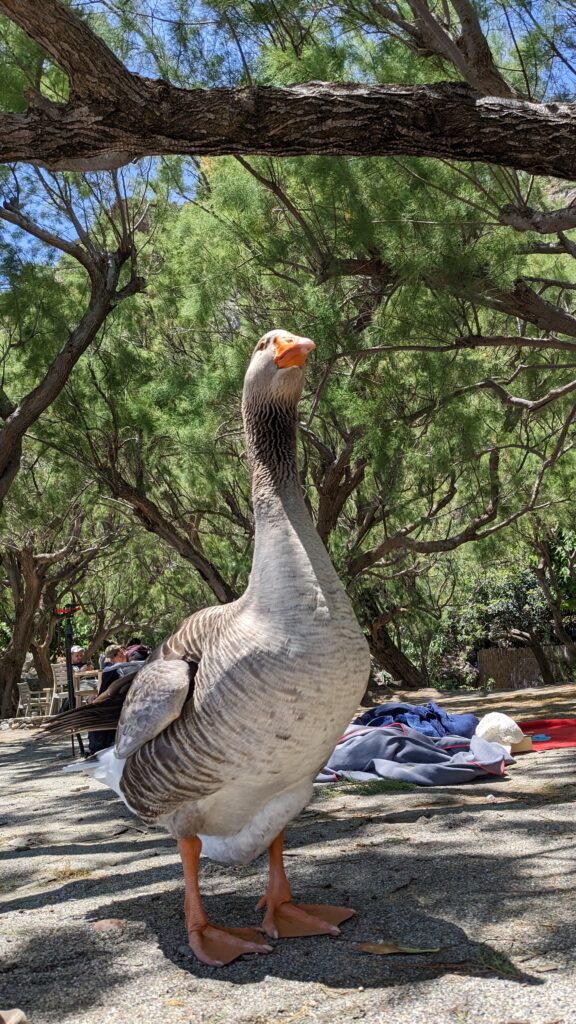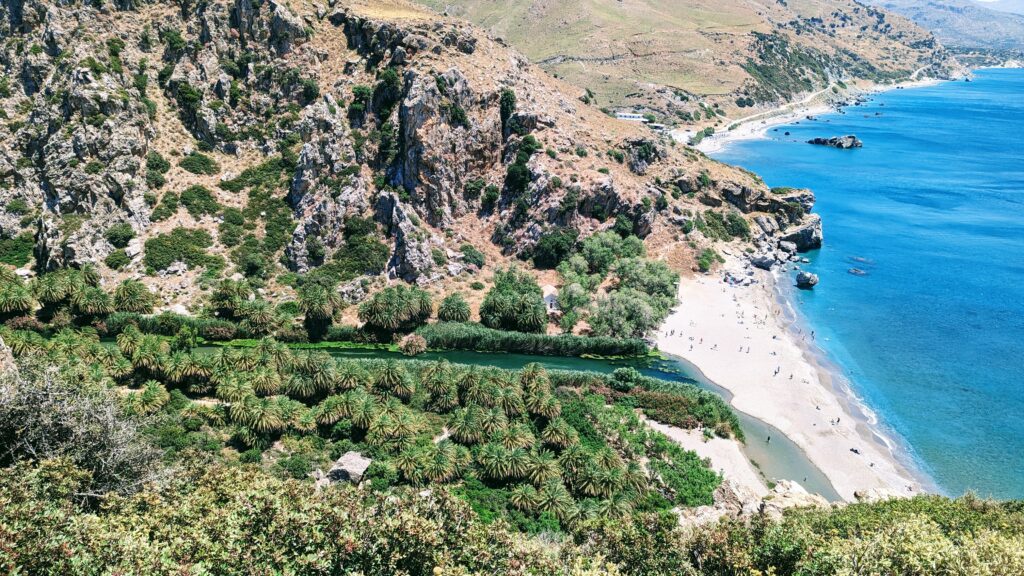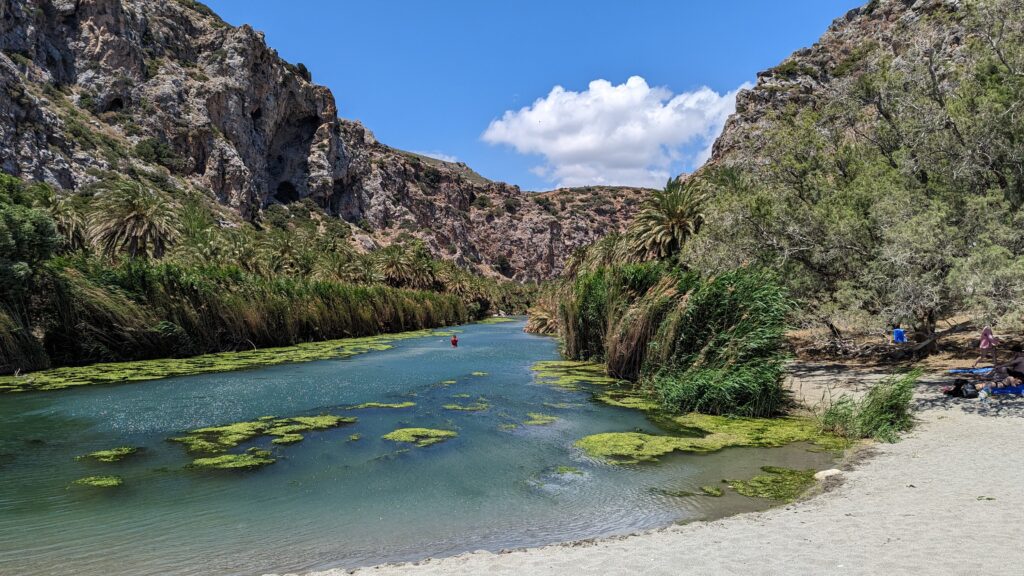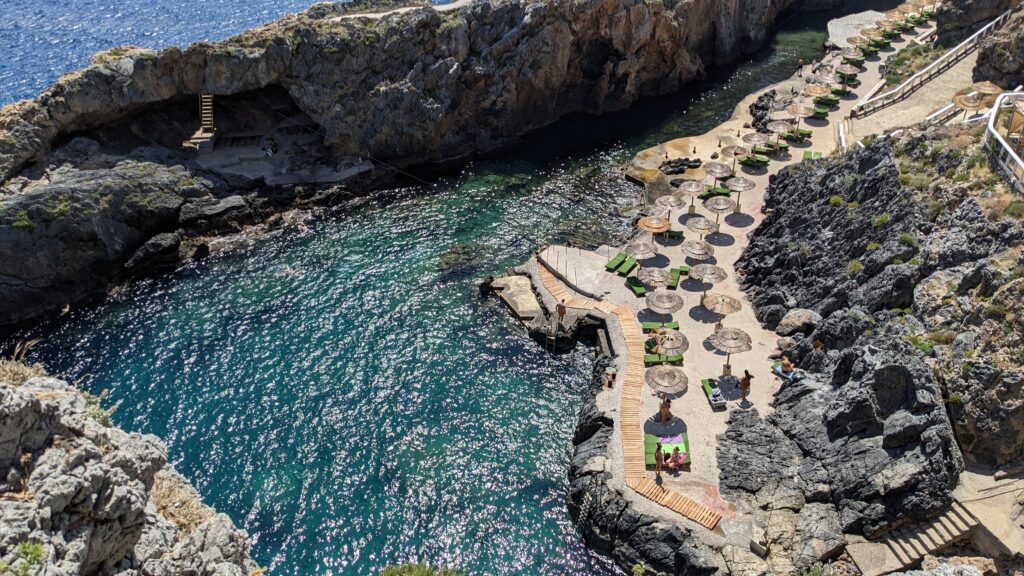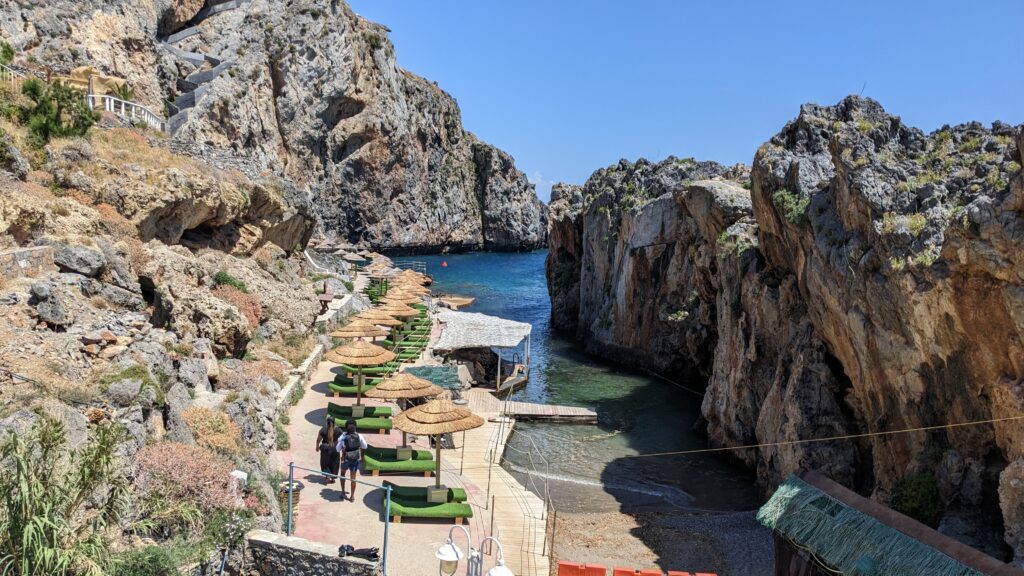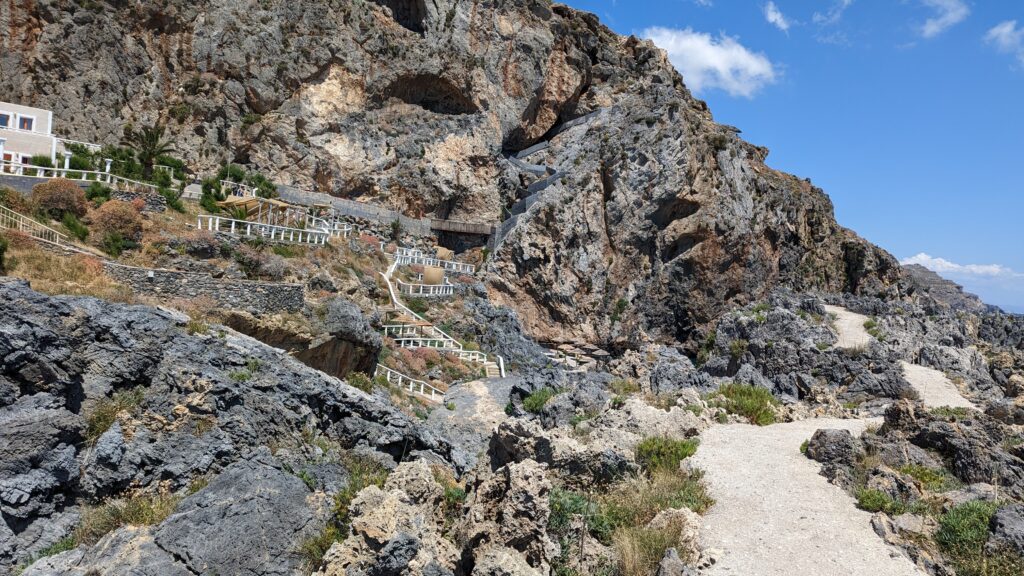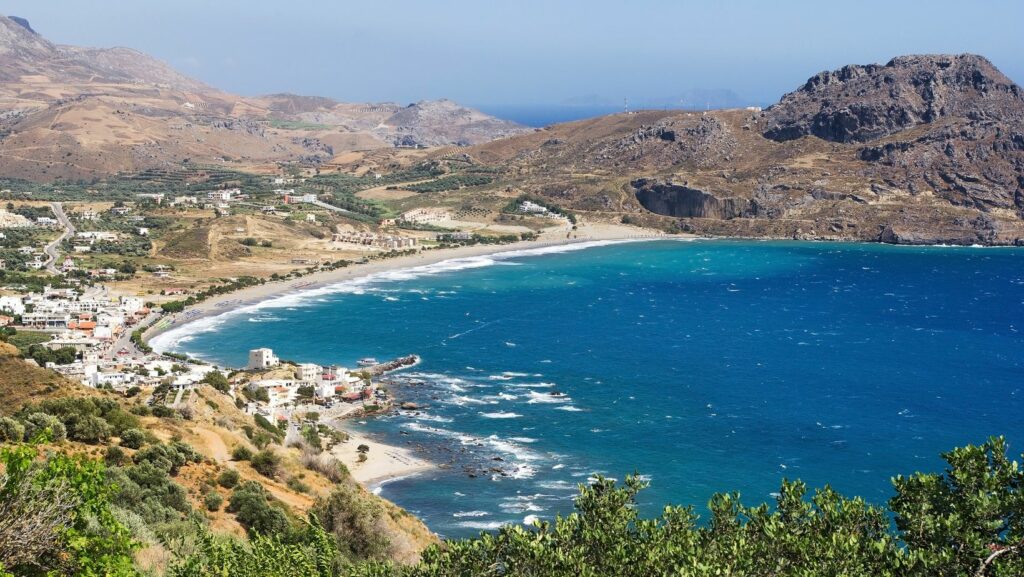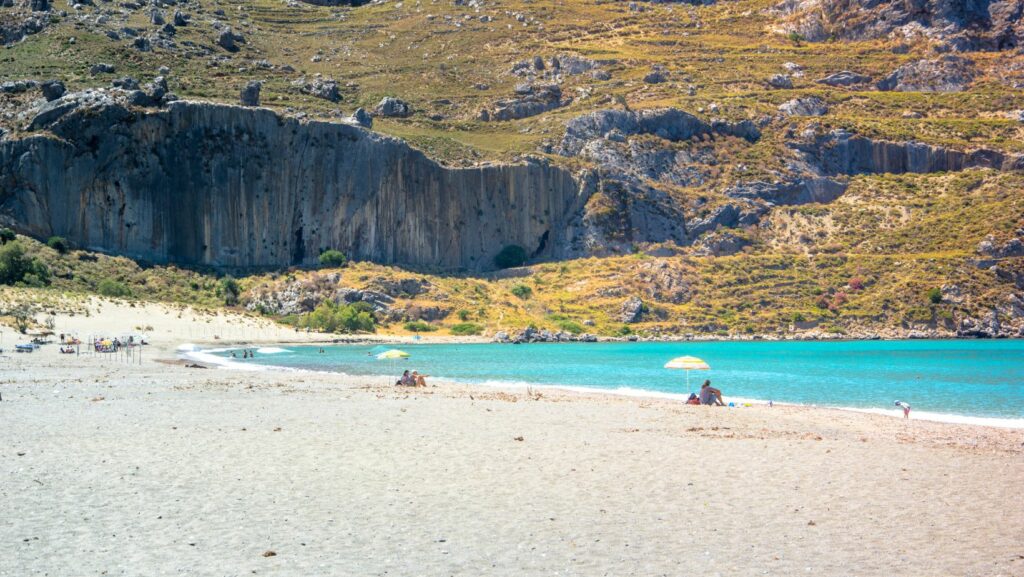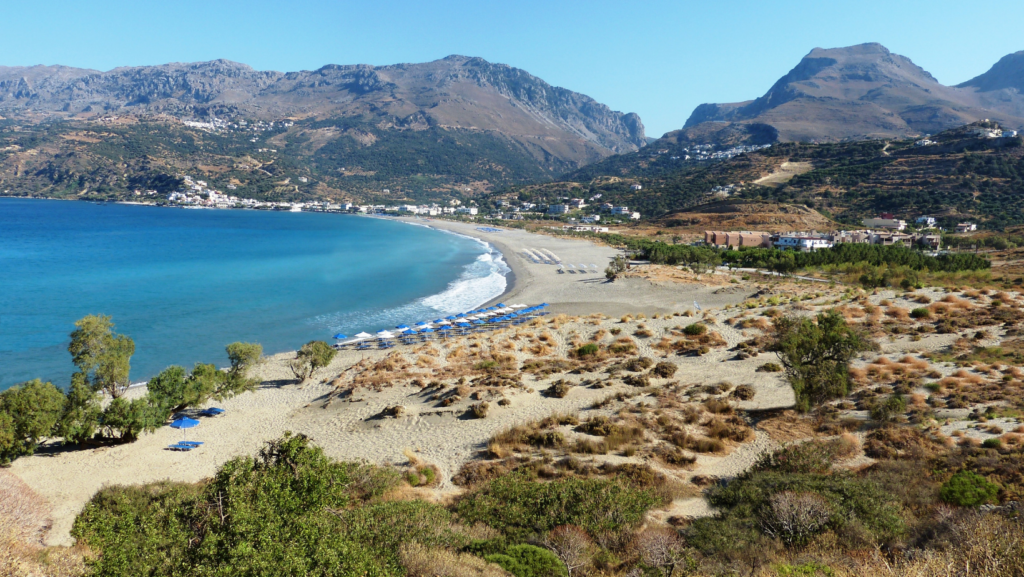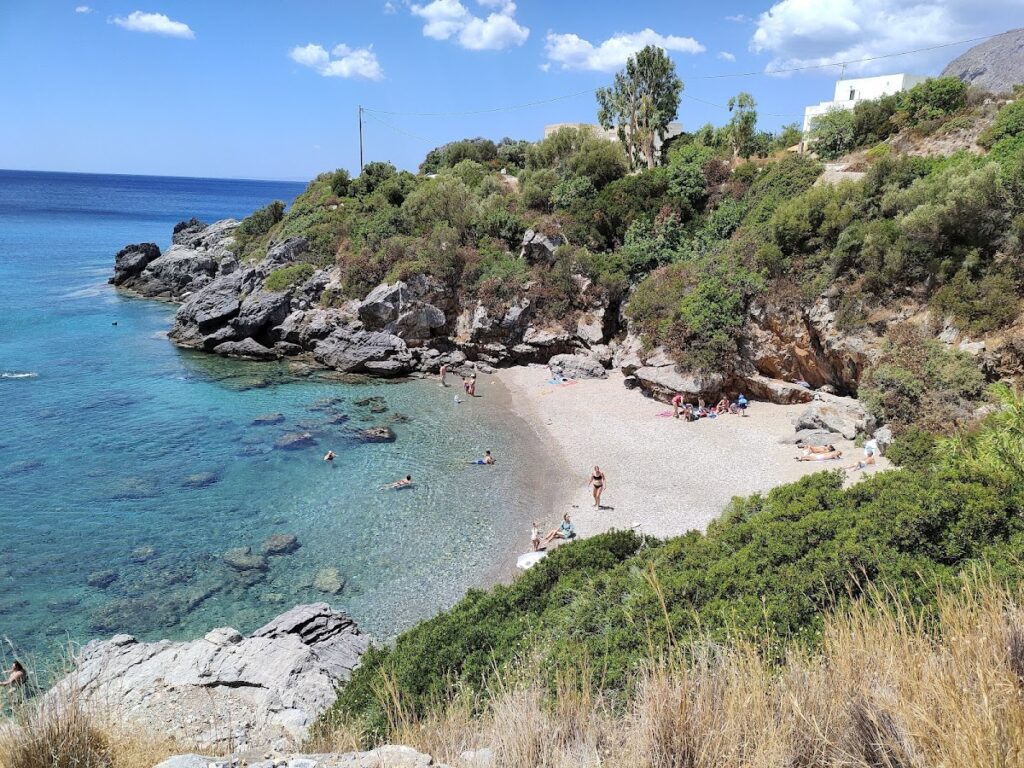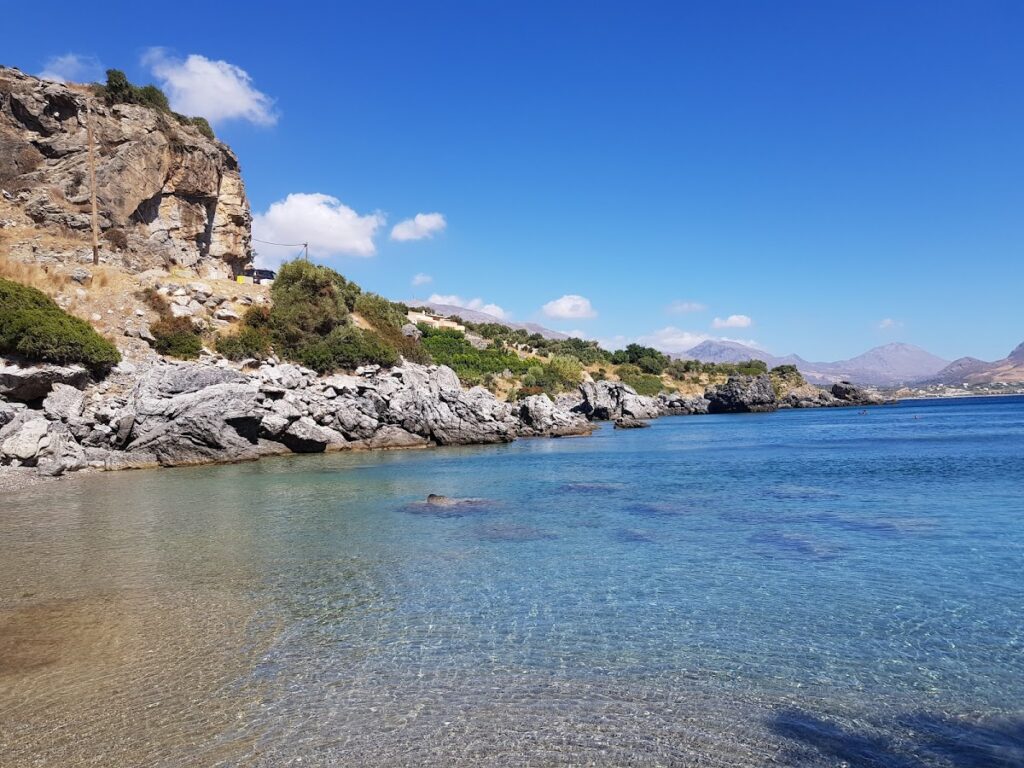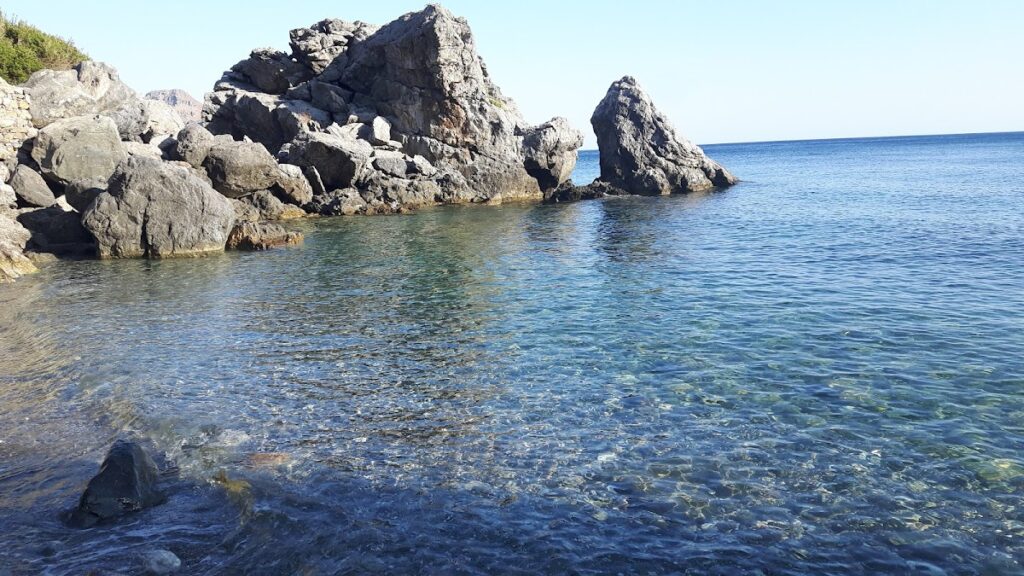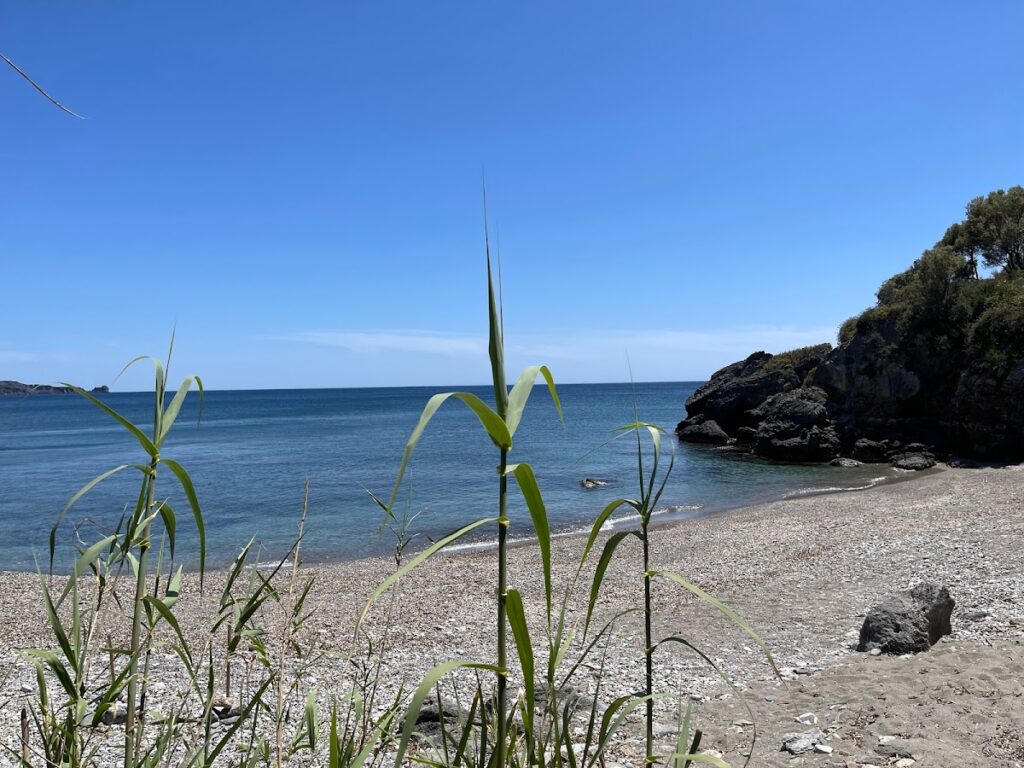Beaches near Lefkógeia, in Rethymno region
Here is list of closest beaches to Lefkógeia
- 2.3 km
- Ammoudi beaches, Plakias
- White Sand
- Normal
- Turquoise
Located 32km south of Rethymno and 4km east of Plakias, you’ll find the beach complex of Ammoudi. Access is available via a paved road from the village of Lefkogia. This road leads you directly to the first beach, Ammoudi, recognizable by its distinctive green slippery rock. The beach has a slight organization, with available amenities such as umbrellas, nearby taverns and rooms, and even a scuba diving centre. Its thick white sand, rocky seabed, and bright green waters make it ideal for diving and snorkelling. There’s also the option to find shade and camp under the many tamarisk trees located next to the beach.
Heading west from Ammoudi, a dirt road begins that will take you towards Damnoni, passing by towering cliffs and impressive rocks. Just 200m west of Ammoudi, along this dirt road, you’ll discover a parking plateau that offers an unrestricted view of Damnoni. Here, you’ll see an enchanting miniature sandy beach, featuring turquoise waters and a unique rock in the sea. Known as Klisidi, this beach is an attractive choice when not crowded, though this is rare during peak season.
Adjacent to Klisidi, you’ll encounter the stunning nudist beach of Small Ammoudi or Ammoudaki. This small beach is popular among nudists for its turquoise waters and exceptional white coarse sand. It also has a small canteen offering umbrellas and sunbeds. On the beach’s west side, you can swim in a marine cave, where the sunlight turns the water a vibrant blue. You can easily walk on the sandy seabed. There’s also an underwater hole connecting Ammoudaki with Klisidi, allowing you to travel between the two beaches with just a dive. If you wish to reach the Ammoudi beaches on foot, simply walk east of Damnoni until you reach Ammoudaki.
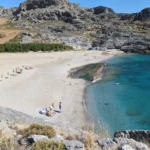
- 2.5 km
- Skinaria beach
- Fine Pebbles, Rocks in places
- Normal
- Turquoise
Located 33km south of Rethymno and 3km south of the village of Lefkogia on Crete Island, you’ll find the small, serene beach of Skinaria (or Shinaria). The beach is situated in the eastern part of the broader Plakias area. Skinaria boasts soft, grey-beige sand and fine pebbles, complemented by the crystal blue depths of the sea. The sea bed is primarily rocky, though the northern part of the beach features sandy terrain.
The area is teeming with life, both terrestrial and marine. Freshwater ponds dot the beach, fed by springs from the Kouroupa mountain. These ponds have fostered lush vegetation around them, giving the area a tropical landscape feel. The local inhabitants claim that the marine life is as vibrant as the terrestrial, and indeed, Skinaria’s seabed is one of the richest on the island. It is home to an abundance of marine creatures, including huge morays, blackfish, and octopuses. Furthermore, the water’s clarity is remarkable, often exceeding 40m horizontally, making it a popular spot for scuba diving centres in Crete.
The beach offers minimal organization, with a local tavern providing a few umbrellas and refreshments. On our last visit, umbrellas and sunbeds were complimentary with a refreshment purchase. Access to the beach is via a narrow, 2km road that begins in Lefkogia. Along the way, an awe-inspiring cylindrical cave can be spotted within a rock on your left.

- 2.7 km
- Damnoni beach
- Sand
- Shallow
- Blue
Situated 35km south of Rethymnon and 5km east of Plakias on Crete island, Damnoni beach is a well-known tourist destination. The resort is fully developed and well-structured, featuring a wide bay with turquoise waters and coarse, whitish sand. Visitors can enjoy numerous facilities including umbrellas, snack bars, showers, changing rooms, and water sports. Additionally, there’s a scuba diving centre, top-notch hotels, restaurants, and a horse-riding centre.
The westernmost part of the beach, which is highly organized, is home to a small river that maintains water nearly all year round. The eastern end of the beach is more serene and connects to the neighbouring Ammoudakii beaches via a short unpaved road. Beyond the western end of the beach, you’ll find several secluded small coves with sand and rocks, located right next to the area’s small harbour.
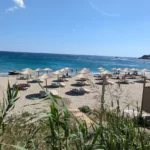
- 4.0 km
- Preveli beach
- Sand
- Normal
- Blue
Nestled approximately 35km to the south of Rethymno and 10km east of Plakias, you’ll find Preveli Beach, also known as Lake Preveli or Phoenix. This gem lies where the majestic Kourtaliotikos Gorge meets the flow of the Grand River (Megalos Potamos). Recognized as the most celebrated beach in southern Crete, it has been a summer haven for countless visitors and was a preferred spot for hippies in the ’60s and ’70s.
In this oasis, a lush colony of Theophrastus palm trees flourishes along the banks of the Grand River, evoking a tropical paradise. The river culminates in a 500m long lake before joining the sea, providing year-round water. You can saunter under the canopy of the palm and other trees, following the river as it ascends through the stunning canyon, and take refreshing dips in the cool pools within the gorge.
In 2010, a major fire devastated this tropical paradise, but remarkably, the palm grove has mostly rejuvenated. At the river’s exit, a beach of pebbles and sand stretches out, where the seawater remains refreshingly cool due to the river. A striking heart-shaped rock adds charm to the eastern section of the beach. Since the area is protected, the beach remains unspoiled, with no parasols.
Venturing to Preveli Beach:
Two main routes lead to Preveli, either from the west or east. One option is driving from Plakias towards the Preveli Monastery, and 1.5km beyond the Kato Monastery of Preveli, you’ll find a spacious car park. Here begins the path descending to the beach. This parking spot offers an extraordinary viewpoint from the towering cliffs to the west, perfect for capturing stunning photos. It’s a 15-20 minute walk to reach the beach, but be prepared for a strenuous climb back up.
An alternative route to avoid the steep ascent involves driving along the paved road to nearby Drimiskiano Amoudi and taking a brief 5-minute walk to Preveli. However, this route doesn’t offer an impressive cliff-top view. You can also opt for a boat ride to Preveli from Agia Galini and Plakias.
The beach owes its name to the nearby historic Preveli Monastery, a male-only monastery established in the 16th or 17th century, dedicated to St. John the Theologian. The old and new monasteries, known as Piso and Kato Monastery respectively, are situated in the vicinity. The former, now deserted, is located just south of the ancient Preveli stone bridge.
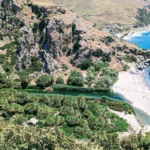
- 4.1 km
- Pirate's Fjord
- Rocks in places
- Deep
- Deep blue
The Kalypso Beach also known as the Pirates’ Fjord is located 33km south of Rethymno, near Plakias. Tucked away in a tiny inlet just south of Mouri or Karavos Cape, this beach is ensconced between towering vertical cliffs. The compact beachfront, starting with a small stretch of sand that quickly transitions to a deep, rocky port, extends no more than 2 meters in width. This secretive cove once served as a refuge for pirates during the Byzantine era, hence its nickname.
Fast forward to today, and you won’t find pirates, but rather a contemporary hotel that shapes the parameters of the “beach.” The hotel has strategically placed loungers and umbrellas on the surrounding smooth rocks, creating a unique sunbathing experience. The Kalypso Beach area also offers opportunities for water activities like scuba diving lessons, courtesy of the onsite diving club, and water pedalo rides. Access to this picturesque beach is through the hotel (via Damnoni) or by a boat trip from Plakias.
The crystal-clear waters of Kalypso beach offer a startling view of the vibrant seabed from above. Every tiny detail of the sea floor is visible, reflecting a mesmerizing underwater world. The water’s hue oscillates from profound blue to a lush blue-green, changing with the depth. The seabed teems with life, making it a perfect spot for snorkelling.
This renowned beach attracts a multitude of visitors, eager to capture the stunning landscape in photographs and plunge into the remarkable bay. Undeniably, the Kalypso beach ranks among Crete’s finest beaches for swimming and snorkelling.

- 4.2 km
- Plakias beach
- Sand
- Shallow
- Blue
Situated 36km to the south of Rethymno city, Plakias is a charming tourist haven nestled at the mouth of a fertile valley just beyond the Kouroupa range, where the Kotsifos river meets the sea. It owes much of its popularity to the impressive Gialia beach, stretching for 1.3km from the edge of the town to the east, ending at Cape Mouri. This fully-equipped beach, characterized by its crystal-clear, cool waters, is an ideal location for leisurely walks or cycling along the adjacent road. It features numerous hotels and restaurants, as well as beach essentials such as umbrellas, water sports facilities, beach volley courts, snack bars, changing rooms, and showers.
Paligremnos, the eastern portion of the beach, boasts fine sandy shores and is well-appointed with various amenities close to local accommodation and eateries. Noteworthy are the tall, vertical cliffs nearby that prove to be a magnet for climbing enthusiasts. This spot, also known as “Gonates” (knees), is steeped in local lore; it’s said that the epic hero Digenis knelt here to drink from a local spring. An intriguing phenomenon takes place here every full moon from September to January, as the moon’s reflection on the sheer cliffs draws large squids to the beach, which locals catch with long sticks. A few meters south of Paligremnos, you can also discover tunnels once used for transporting coal to waiting cargo ships.
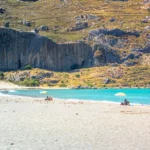
- 4.2 km
- Drymiskos beaches
- Rocks in places, Sand
- Deep
- Blue
Beyond the charming village of Drymiskos, a sequence of coves unfurls into a series of beaches spanning 3 km, collectively known as Drymiskiani Gialia (Drymiskos Beach). Rocks and reefs segment these beaches, providing an exciting snorkelling experience. The area remains largely undiscovered due to its more challenging accessibility compared to other locations in the South Rethymnon prefecture. The most well-known section of Drymiskian Beach is Amoudi, the westernmost beach where the paved road from Preveli beach ends. Ammoudi serves as the starting point for a brief trail to Preveli beach, where most visitors park their cars.
Venturing eastwards from Amoudi along the paved road, one can discover numerous serene sandy beaches, perfect for solitude and naturism. At the heart of Drymiskian Beach, Kefala’s beaches are marked by a distinctive black, tooth-like rock jutting from the sand. The best beaches in the area can be found on either side of this rock. Continuing further, one reaches the less crowded Anatolika beaches, also known as East, renowned for their deep, clear waters. From Anatolika, the journey can be extended to the Kerames beaches, the first of which is Gialopotama. While most beaches lack trees, large rocks provide ample shade throughout the day.

- 6.6 km
- Gialopotama beach, Kerames
- Rocks in places, Sand
- Normal
- Blue
Gialopotama is located about 45km south of Rethymno city, 4km south of the village Kerames and near the exit of a small valley, where a small stream flows. The beautiful unknown beach of Gialopotama is formed west of a small hill, on which a few small houses and apartments for renting were built in the last decades.
The beach is sandy with rocks in places. The rocky bottom makes it ideal for snorkelling and spearfishing. It is unorganized and appropriate for isolation. Especially, its eastern part, where huge boulders are dispersed, can be visited for naturism.
Gialopotama can be accessed by car via asphalt road from Kerames village or via a paved track starting east of Preveli beach and coming along the coastline of Drymiskos.
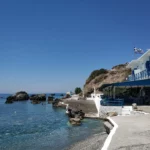
- 6.6 km
- Fotinari beach
- Fine Pebbles, Pebbles, Rocks in places
- Normal
- Blue, Green
Situated 37km south of Rethymno, nestled between Plakias and Souda’s beach, Fotinari (also known as Foteinari) offers two serene beaches resting in a compact bay rich with vegetation. The rocky seabed provides a perfect spot for fishing and snorkelling activities.
These adjoining pebbly beaches lack organisation, however, you can easily find accommodation and dining options nearby. As you approach from Plakias, heading towards Souda beach, the first beach you’ll encounter is the Small Fotinari, also referred to as Fotinaraki, due to its smaller size compared to the following beach, the Big Fotinari.
Both beaches are conveniently located near the main road, which runs directly over them. Two brief stone paths cut through a pair of small woods, leading straight to the beach. Additionally, Big Fotinari offers shade beneath the towering rocks that surround it.
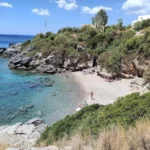
- 7.0 km
- Pirgos beach, Kerames
- Pebbles, Rocks in places
- Normal
- Blue
Two neighboring beaches, named Pirgos, are nestled between Gialopotama and the Agia Fotini harbor. These beaches, adorned with fine sand and pebbles and bordered by towering rocks, are perfect for those who enjoy snorkelling and naturism due to their potential for solitude. A dirt path leading to Pirgos begins 500m north of Gialopotama, though you can also choose to walk from Gialopotama along the rocky shoreline. Overlooking Pirgos are three striking caves.
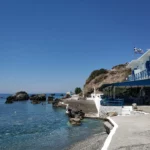
No results available
ResetBeaches in other nearby areas
No results available
Reset
